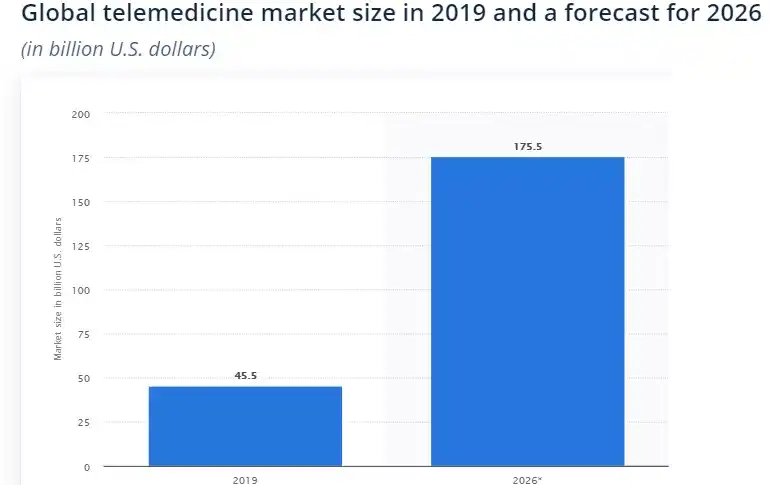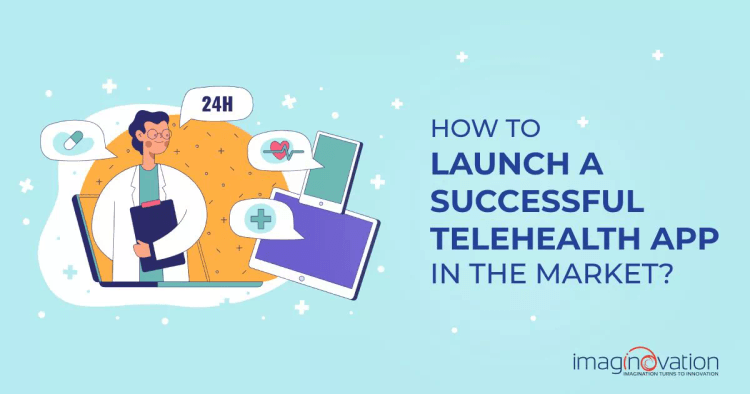The coronavirus epidemic is escalating worldwide. Our healthcare systems today need out-of-the-box solutions due to the increasing influx of patients.
Telemedicine app development has shown promising benefits in curbing transmission and improving patient care. It is encouraging to see telehealth apps meeting the challenges posed by the coronavirus.
As a healthcare executive, this niche area will interest you. It is the best time to invest in telehealth app development, as the demand for such services will continue to rise. Keep reading to understand how to launch a successful telehealth app, along with its benefits and some examples.
The Surge in Telemedicine: Some Statistics
Digital technology is helping healthcare organizations optimize services and patient outcomes.
As 2024 reshapes our health systems, healthcare executives can expect a surge in the telemedicine sector. Let’s look at some statistics that highlight the use of telemedicine.
- The World Health Organization (WHO) recommends telemedicine as a practical solution to deliver some routine services. (Source)
- Statista predicted (before the pandemic) that the telemedicine market size would increase to $460 billion by 2030.
- Statista also projected significant growth in the telemedicine market by 2030, with an estimated valuation of more than 224.8 billion U.S. dollars.

Image 1: Global telemedicine market size in 2019 and a forecast for 2026
- The global telemedicine market size is expected to grow at a CAGR of 19.28% by 2025.
- Customer adoption of telehealth has accelerated, with 11% of U.S. consumers using telehealth in 2019, increasing to 46% of consumers.
- Additionally, 57% of providers now view telehealth more favorably than before COVID-19, and 64% are more comfortable using it.
The statistics are encouraging. Moving forward, you can choose to develop your business app to strengthen healthcare services.
The telehealth app development process may be challenging, but creating an app with profound benefits can be tremendously satisfying.
Telemedicine App Development: Step-by-Step Guide to Start Your App
You can divide the telemedicine app development process into two phases—Discovery and Development. Begin by focusing on accomplishing both stages.
At the heart of development is the intent to bring innovative solutions. If you commit to each step in the various stages, you will enjoy the telehealth app development process.
Let’s start with the Discovery phase.
1. Evaluating Your App Idea
It’s always a great idea to evaluate your concept. Where to begin?
Conduct business analysis—You can define your target audience. This step helps you start researching the audience’s needs, requirements, patterns of use, and more.
Quick tips:
- Define your target audience
- Brainstorm the purpose of the telehealth app
- Create a business plan for the project
Do a SWOT analysis—In this step, reflect on your strengths and weaknesses. Next, identify the telemedicine market leaders and probable competitors.
Research your competitors’ success stories, ratings, and user reviews. Also, examine their prices and platforms. This step will help you identify gaps and learn from market leaders.
Wait! Did we mention prices? So, how much does it cost to develop a telehealth app?
It depends on the concept, features and functionality, development approach, and chosen development vendor. You can expect the app to cost around $80k to $250k for one platform (iOS, Android, or Web). It can go well beyond $250k per platform if you choose to work on a feature-rich solution.
Build on USP—Your business has its USP, and that’s what you can optimize. Leverage your strengths and offer distinctive features that cater to your target audience, providing them with value.
2. Consulting a Telemedicine Service Provider
You will find a plethora of telemedicine app development companies. Wouldn’t it be great to find a consulting partner who understands your app idea and makes it a digital success?
To find an excellent healthcare IT solutions vendor (consulting partner), do the simplest thing: research. Conduct thorough research and shortlist some development companies that align with your vision. Also, consider price and expertise as part of your research parameters.
3. Creating Project Scope
The app’s scope document is a critical step. Reach out to application and software developers and explain the aim of your telemedicine app.
Next, business analysts and project managers can assist with app features, wireframes, project mock-ups, and prototypes. The company will also help you develop features according to market and consumer expectations.
What can you do?
You can contribute to the process with constant feedback. This will help keep the company aligned with the budget and timeline requirements for the telemedicine app development.
After the initial Discovery phase, it’s time to explore Development. The telehealth app development consists of the app coding phase. The development team organizes processes and sprints to meet deadlines.
4. Looking at Development
This step focuses on delivering the first app version with core features, incorporating scalability for future versions.
You may choose to launch a fully-featured telemedicine platform, but the expenses could be higher for such versions. The application development team will plan to develop the code, conduct testing, and fix any bugs.
What can you do? You need to understand the diverse technologies used in telemedicine app development. Awareness can help you effectively integrate technology into your app. Let’s take a quick look.
Table 1: Technologies used in Telemedicine App Development
| \\\*\\\*Technologies\\\*\\\* | \\\*\\\*Usages\\\*\\\* |
| Artificial Intelligence (AI) | \\\[Voice recognition](/blog/driving-roi-with-voice-technology-healthcare/), language processing, machine learning, chatbots, and offering a personalized experience to users. |
| Big Data | Collect and analyze EHRs (electronic healthcare records), run medical research, improve treatment, provide accurate diagnoses |
| Blockchain | Prevent loss of healthcare data (stored in soft copy format) and ensure secure collection and transfer of medical data |
| IoT | Track data, offer diagnosis and treatment, medication adherence, real-time treatment, etc. |
You will enjoy blending your expertise with a vision of how the product can grow. It is always satisfying to see the app evolve and contribute to the future healthcare landscape.
5. Approving the App’s Demo
Once the app is ready, the development team will present the app demo. This step is an excellent opportunity to determine whether the app meets your requirements and request any improvements.
What can you do? Provide constant feedback, ensuring transparency and minimizing the risk of miscommunication.
What matters most is that the result aligns with your dream app idea. You can tweak the features until they match the exact blueprint you envisioned.
6. Launching Your Telemedicine App
After rigorous app testing and a final product demo, you can prepare to launch your telemedicine app. Finally, your dream app, with all its features, can serve the target audience.
To ensure the efficiency of your telehealth application, here are some quick tips:
- Collect user feedback, analyze it, and promptly address any issues
- Add new features to address gaps and improve the app's efficiency
With your dream app now a digital reality, it can enhance patient care and boost ROI. There’s no doubt that a telemedicine app can be a powerful tool for both doctors and patients.
Lisa Hedges, reiterates: “From a recent survey we conducted of U.S. patients, we found that 84% are more likely to select a provider that offers telemedicine over one that doesn’t, so it’s clear this technology is something patients want.”
Now, that reflects the sentiments of the healthcare landscape.
Next, let’s look at some outstanding benefits.
Why Develop A Telemedicine App?
Telehealth is revolutionizing healthcare. You can unleash the full power of telehealth to benefit both patients and businesses.
As reiterated by Dedi Gilad, Tyto Care: by deploying telehealth solutions and programs, people [patients] who are suffering from other medical ailments during this time [COVID-19] can receive care from home. He adds that by avoiding medical facilities, they minimize their risk of contracting the virus. Gilad highlights the critical need of the hour.

1. Minimizing Risk to Healthcare Workers
With the global pandemic, many chronic patients prefer to schedule teleconsultations to avoid face-to-face clinic visits.
This option helps minimize the risks of exposure to the coronavirus. You can offer a 24/7 lifeline for patients, connecting them to their providers through the app. This feature adds comfort and assurance for patients during trying times.
2. Triaging, Screening, Contact Tracing, and More
You can use telehealth to screen for COVID-19 symptoms. Phone screenings and virtual telemedicine visits can help evaluate patients.
The development team can include screening algorithms to conduct remote evaluations of patients' medical conditions.
With telehealth, it is easy to interview patients with COVID-19 to determine whom they were in contact with during that time. Following up with their contacts and evaluating symptoms becomes straightforward. These new features will prove helpful.
3. Cutting Down Healthcare Costs
With remote healthcare services, many businesses don’t need to worry about renting a workspace.
Startups like Doxy.me allow physicians to offer telemedicine services on a subscription basis. Now, that’s cool! Many doctors can benefit from telemedicine app development as the overall consultation process becomes faster.
4. Convenient and Time-Efficient Treatment
Picture this—patients spending extra time traveling to a hospital. They would need to travel and then wait in line for a preliminary doctor consultation. Yes, you’ve got it! The process used to be frustrating and time-consuming.
With telemedicine apps, patients can schedule appointments for remote medical help. The patient and doctor can connect at a convenient time. The process has become more efficient with telemedicine applications.
5. Convenient Access to EHR
Doctors need quick access to EHRs, and telehealth software can provide this on demand. The process saves doctors' time.
Patients can also stay updated about revisions made to their EHR. However, the process needs tight security features to prevent any health record leaks. A robust app can address such issues.
6. Easier Access to Healthcare
Picture this—people living in distant, rural areas with no access to nearby healthcare facilities. As a healthcare executive, telemedicine can be an invaluable solution if you aim to increase healthcare accessibility.
Telehealth apps can benefit people in such areas. All they need is an app and a cellular network or WiFi. An added advantage is that people from countries with low levels of healthcare can also seek consultations from foreign physicians.
7. Unified Patient Management and Monitoring System
Telehealth app solutions can aid in follow-up consultations. The apps can also help with prescription updates, chronic disease monitoring, and more.
8. Optimizing Administrative Operations
Telemedicine apps can help free up time for essential tasks. With most paperwork automated, inefficiency is reduced. The result—you can aim for higher profits.
At a time when the pandemic has introduced new challenges, you can expand access and improve patient care with telehealth app development. You can launch a telemedicine app that delivers high-quality care to consumers. The time to act is now!
Develop a Successful Telehealth App with Imaginovation
We understand that you want to curate a delightful experience for your target audience and streamline workflows with telehealth. If you feel overwhelmed by the process and are serious about launching a successful telehealth app, get in touch with us.
Ready to build an app, but not sure where to start?
We've got you covered. Click the button below to get started.





